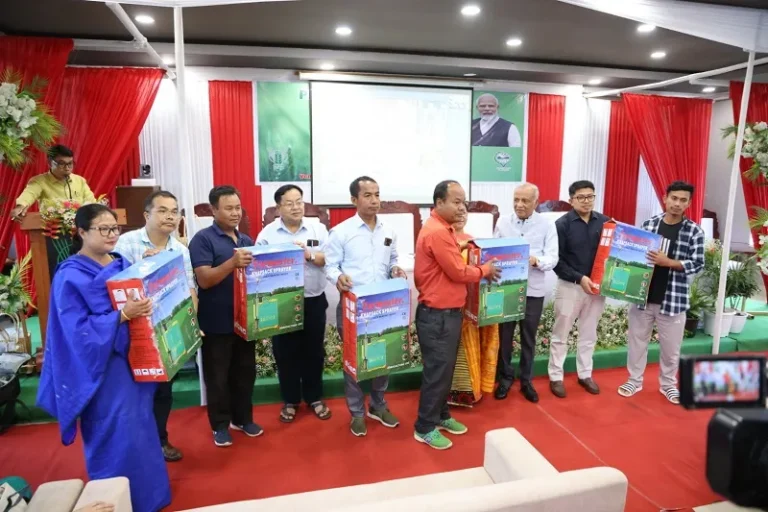Manipur: Successful Rescue and Release of Long-Tailed Broadbills at Kangla Fort
Wildlife experts in Manipur successfully rescued two baby Long-tailed Broadbills that were trapped in a house in Imphal. After their safe retrieval, these vibrant birds were released back into the wild at Kangla Fort, known for its dense forest cover. The rescue operation was part of broader efforts by environmental organizations like People For Animals and People for Nature to combat wildlife poaching. The Long-tailed Broadbill, a striking bird found in the Himalayan region, represents a key focus for conservation efforts in Manipur.
Long-Tailed Broadbills: A Glimpse Into the Rescue and Release
Introduction to the Rescue
Manipur, a region known for its rich biodiversity, witnessed an inspiring conservation effort recently. On November 9, 2024, two baby Long-tailed Broadbills, which had been trapped in a residential home in Imphal, were rescued and successfully released back into the wild. This rescue mission was carried out by the Wildlife Conservation Committee of Manipur, with the active participation of other environmental organizations.
The birds were found at the residence of Maibam Premkanta in Khurai Lairik Lengbam Maning Leikai. Upon receiving the distress call, wildlife experts swiftly arrived on the scene and carefully retrieved the birds. The rescue was handled with great caution to ensure the birds’ safety and minimize any trauma from their temporary captivity.
Why the Kangla Fort Release Was Significant
The release of the rescued birds took place in the historic Kangla Fort, often referred to as the “Lungs of Imphal.” Known for its dense forest cover, the area provides an ideal natural habitat for the Long-tailed Broadbill. The fort is not only a historical site but also a critical ecological zone that helps preserve local flora and fauna.
Kangla Fort’s lush surroundings make it an important sanctuary for a wide variety of species. The Long-tailed Broadbill, in particular, benefits from the habitat’s dense canopy and rich biodiversity. Its vibrant plumage and distinctive tail feathers add to the aesthetic and ecological value of the region.
The Role of Local Organizations in Wildlife Conservation
Several local organizations, including People For Animals and People for Nature, have been actively campaigning against wildlife poaching, especially in sensitive areas like the Loktak Lake and Ikop Pat. Their efforts aim to educate locals and raise awareness about the harmful effects of trapping and poaching. Through these campaigns, they have worked tirelessly to protect species like the Long-tailed Broadbill from illegal activities that threaten their existence.
This particular rescue and release event underscores the importance of collaborative efforts between wildlife authorities, conservation groups, and local communities. By working together, they ensure that such species can thrive in their natural environment and contribute to the ecological balance.
Understanding the Long-Tailed Broadbill
The Long-tailed Broadbill (Psarisomus dalhousiae) is a species known for its vivid green and yellow plumage, complemented by striking blue and black markings. It is found primarily in the Himalayan region and parts of Southeast Asia, including areas like Myanmar, Thailand, and Laos.
This bird is the sole member of its genus, Psarisomus, and has a distinctive appearance with long, flowing tail feathers that make it stand out in the dense forests it inhabits. Despite its beauty, the Long-tailed Broadbill faces several challenges in the wild, including habitat loss and the threat of illegal trapping.
As part of a broader conservation strategy, experts aim to monitor and protect the species to ensure its survival for future generations. The release of the two rescued birds back into the wild serves as a step in the right direction for safeguarding this remarkable species.
The Bigger Picture: Poaching and Wildlife Protection
One of the major challenges in Manipur—and across many parts of India—is the illegal trapping and poaching of wildlife. Birds like the Long-tailed Broadbill are often captured for their striking feathers or sold in illegal wildlife trade markets. Such activities not only disrupt local ecosystems but also endanger species that are already at risk.
Efforts by environmental organizations, government agencies, and wildlife conservationists are crucial in curbing these activities. Public education on the importance of biodiversity and the dangers of wildlife trade has become a cornerstone of many of these initiatives. Without such efforts, many species face the risk of extinction.
A Call to Action: Supporting Wildlife Conservation
The successful rescue and release of the Long-tailed Broadbills serves as a reminder of the need for continuous support for wildlife conservation. It’s not enough to just hope that these species survive in their natural habitats—active intervention, education, and strict enforcement of wildlife protection laws are essential.
Each rescue mission, each piece of education, and each effort to preserve wildlife in places like Kangla Fort brings us closer to a more sustainable future for both humans and animals. By participating in or supporting such initiatives, individuals can help contribute to the protection of endangered species.
Conclusion
In conclusion, the rescue and release of the Long-tailed Broadbills in Kangla Fort represents a positive step for wildlife conservation in Manipur. It highlights the importance of protecting endangered species and the vital role that local communities and organizations play in these efforts. While challenges remain, this event provides hope and inspiration for future conservation projects in the region.
As we continue to face environmental and ecological challenges, the story of the Long-tailed Broadbills serves as a testament to the resilience of nature—and the collective responsibility we all share in preserving it for future generations.
FAQs
- What is the Long-tailed Broadbill? The Long-tailed Broadbill (Psarisomus dalhousiae) is a brightly colored bird native to the Himalayan region and Southeast Asia, known for its distinctive green and yellow plumage and long tail feathers.
- Why was the rescue of the Long-tailed Broadbills significant? The rescue was significant because it highlighted the importance of wildlife conservation efforts and provided an opportunity to release the birds back into their natural habitat, ensuring their survival.
- What is Kangla Fort, and why was it chosen for the release? Kangla Fort is a historic site in Imphal, known for its dense forest cover. It provides a safe and natural environment for the rescued Long-tailed Broadbills to thrive.
- Who was involved in the rescue operation? The rescue operation was carried out by the Wildlife Conservation Committee of Manipur, with the help of environmental organizations like People For Animals and People for Nature.
- How can individuals contribute to wildlife conservation? Individuals can support wildlife conservation by raising awareness, participating in local conservation efforts, and advocating for stronger protection laws to prevent poaching and habitat destruction.



